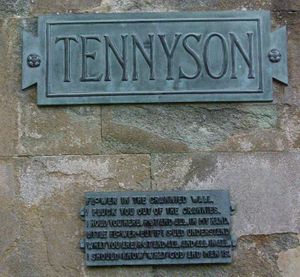زهرة في الحائط المتشقق

"زهرة في الحائط المتشقق Flower in the Crannied Wall" هي قصيدة في سنة 1863 قرضها ألفرد تنيسون.[1]
. . . . . . . . . . . . . . . . . . . . . . . . . . . . . . . . . . . . . . . . . . . . . . . . . . . . . . . . . . . . . . . . . . . . . . . . . . . . . . . . . . . . . . . . . . . . . . . . . . . . . . . . . . . . . . . . . . . . . . . . . . . . . . . . . . . . . . . . . . . . . . . . . . . . . . . . . . . . . . . . . . . . . . . .
النص
زهرة في الحائط المتشقق،
قطفتك من الشقوق،
أمسكتك هنا، بجذرِك وكـُلـِّكِ، في يدي،
أيتها الزهرة الصغيرة—آه لو تمكنتُ من الفهم
ما أنت، بجذرِك وكـُلـِّكِ، كلك عموماً،
فلسوف أعرف الله والإنسان.
تحليل
Tennyson composed the poem by the wishing well at Waggoners Wells.[2]
The Tennyson memorial statue (1903) by George Frederic Watts at Lincoln shows him holding a flower in his hand and a plaque with this poem.[3] The phrase flower in the crannied wall is sometimes used in a metaphorical sense for the idea of seeking holistic and grander principles from constituent parts and their connections.[4]
المراجع
- ^ Jerome Berryman (2017). Becoming Like a Child: The Curiosity of Maturity Beyond the Norm. Church Publishing, Inc. pp. 75–. ISBN 978-0-8192-3323-3.
- ^ Wishing Well
- ^ Monument to Lord Tennyson
- ^ Brandom, Robert (1981). "Leibniz and Degrees of Perception". Journal of the History of Philosophy. 19 (4): 447–479. doi:10.1353/hph.2008.0100.

